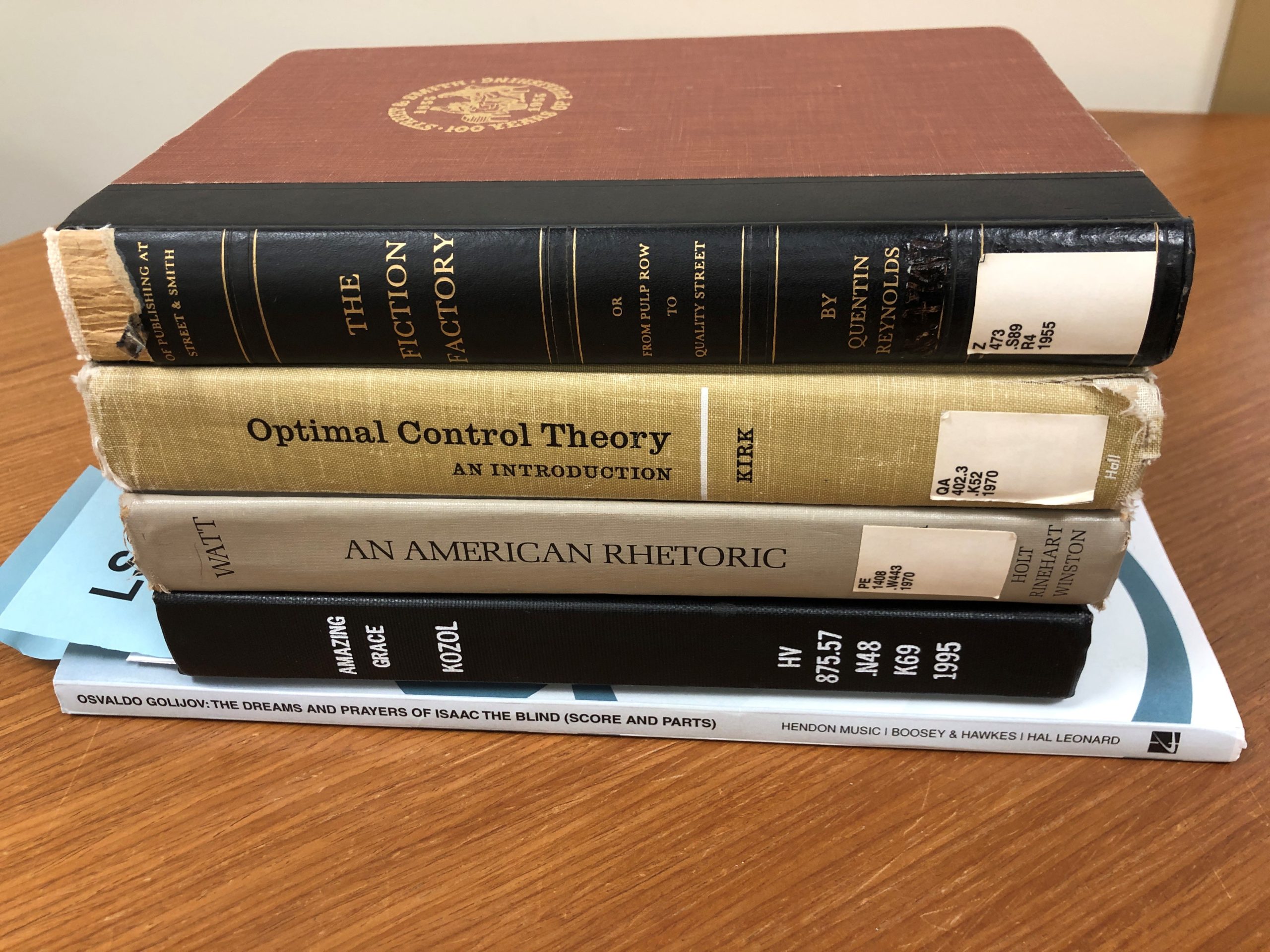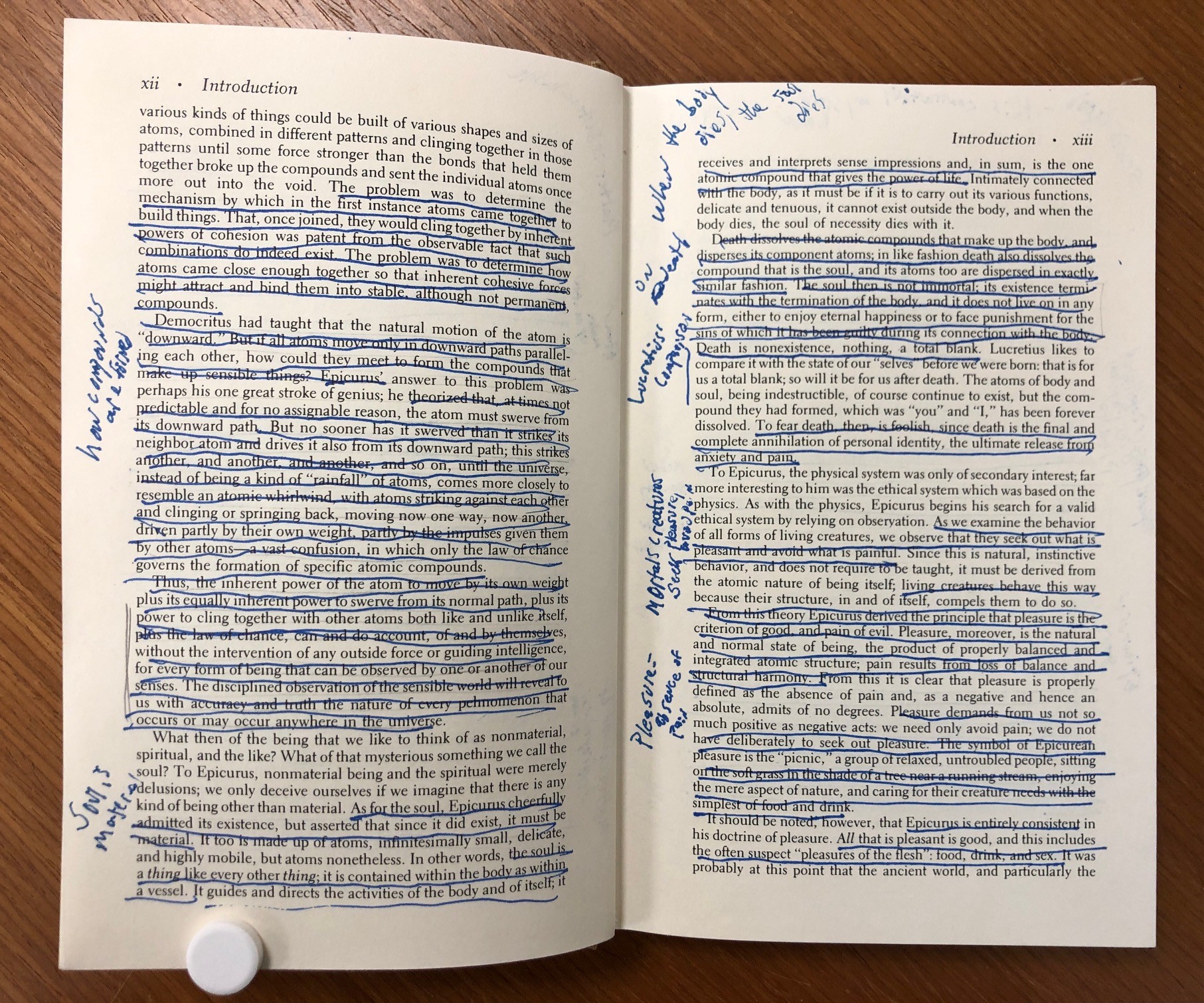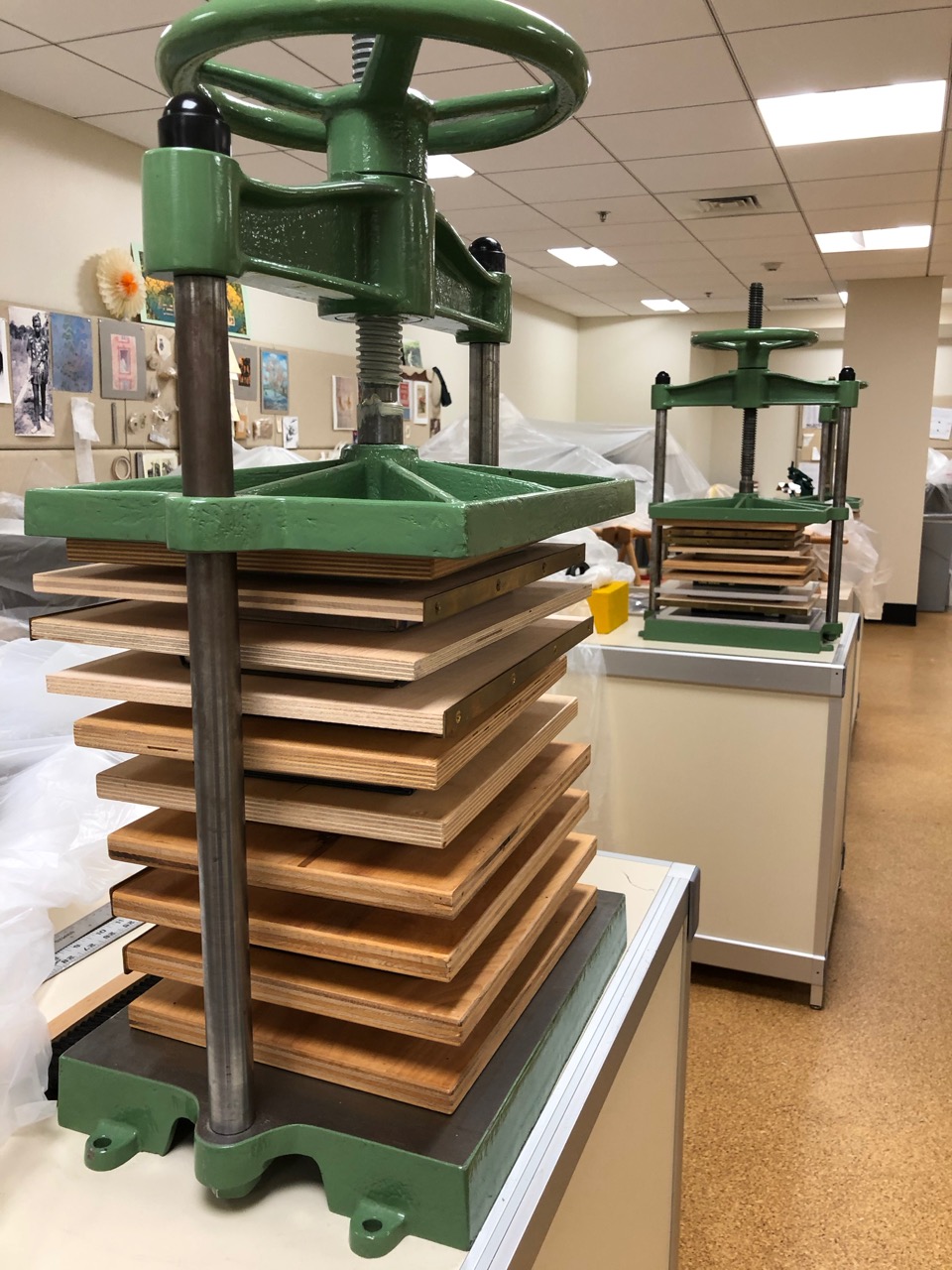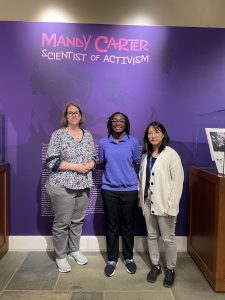

January is the Schrödinger’s Cat of months. It goes by quickly, and drags on and on.
Happy New Year to all our followers!


January is the Schrödinger’s Cat of months. It goes by quickly, and drags on and on.
Happy New Year to all our followers!
Duke University Libraries is seeking applicants for Senior Conservation Technician in the Verne and Tanya Roberts Conservation Lab. Come join our team!

The job announcement outlines further job responsibilities and the application requirements: https://library.duke.edu/about/jobs/srconservationtechnician
Applicants invited for an interview will be expected to present a portfolio of work.
Salary dependent on qualifications and experience; anticipated salary range $50,000-$60,000. Comprehensive benefits package includes 15 days vacation, 14 holidays, 12 days sick leave; health, dental, disability and life insurance and support for professional development and training.
The Duke University Libraries are the center of intellectual life at Duke, one of the most highly ranked private universities in the nation. The William R. Perkins Library, Bostock Library, David M. Rubenstein Rare Book & Manuscript Library, and von der Heyden Pavilion comprise the university’s main library complex, which is joined on East Campus by the Lilly and Music Libraries, and by the Pearse Memorial Library at the Duke Marine Lab. Together with the separately administered libraries serving the schools of Business, Divinity, Law, and Medicine, they comprise one of the country’s top 10 private research library systems. Consistently recognized as a great place to work, we strive to provide an inclusive, safe, and welcoming environment with equitable support for all people.
More information about the Duke Libraries and the Verne and Tanya Roberts Conservation Lab can be found here:
Where Curiosity Leads, the Duke University Libraries Strategic Plan, 2024-2029
Diversity, Equity, and Inclusion at Duke University Libraries
Duke Libraries Conservation Services Department
Located halfway between the Great Smoky Mountains and the beaches of the Atlantic, Durham is home to hundreds of restaurants, more than 40 annual festivals, Duke and North Carolina Central universities, art and science museums, world-class medical facilities, and a rapidly growing, richly diverse population. One of three cities that make up North Carolina’s Research Triangle, Durham is known as a vibrant hub for innovation and technology, as well as an incubator of many successful start-ups. It is consistently ranked among the best places to live, do business, and retire. Learn more at https://durham.duke.edu/.
Duke University consistently ranks among the best employers in the country. Duke offers a comprehensive benefit packages which includes both traditional benefits such as health insurance, leave time and retirement, as well as wide ranging work/life and cultural benefits. Details can be found at: http://www.hr.duke.edu/benefits/duke_benefits.html .
https://library.duke.edu/about/jobs/srconservationtechnician
 We are delighted to welcome our sixth HBCU Library Alliance intern, Angela Nettles, to Duke Libraries. Angela is a rising senior at Bennett College where she is studying Africana Women’s Studies. She is also one of eight students studying preservation this summer through the University of Delware/HBCU-LA internship program. As a part of the program, she will spend four weeks with us learning everything from binding pamphlets to conducting condition surveys.
We are delighted to welcome our sixth HBCU Library Alliance intern, Angela Nettles, to Duke Libraries. Angela is a rising senior at Bennett College where she is studying Africana Women’s Studies. She is also one of eight students studying preservation this summer through the University of Delware/HBCU-LA internship program. As a part of the program, she will spend four weeks with us learning everything from binding pamphlets to conducting condition surveys.
After two years of presenting this program online, it’s refreshing to have our intern onsite again. So far, this first week has been a busy one. In addition to her bi-weekly cohort meetings, Angela has dived right into work here at Perkins Library.
To start, she spent the first half of the week assisting the Exhibition Department to set up the “Mandy Carter, the Scientist of Activism” exhibit.


As you can imagine, there was a lot to be done. Regardless, Angela was up to the many tasks at hand. From sanding the walls to setting up exhibit cases, she eagerly took part in every step of the process.

Additionally, the second half of the week was spent introducing Angela to my work in the conservation lab. She learned about how we make treatment decisions for general collections, and has already started doing treatments herself.

So far she is a quick study and has already picked up how to do tip-ins, pockets, and pamphlet bindings.
Angela hit the ground running during the first week of her internship, and we have appreciated her enthusiasm to learn and try new things. We can’t wait to see what else she will accomplish during the rest of her time with us! You can read about the full cohort of interns on the HBCU-Library Alliance blog post. You can find posts from our past interns here.
Spanish is not my native language. Luckily, I can read it well enough to appreciate this compelling and solemn work by the Columbian poet Francia Elena Goenaga. The cover image does not reveal much about the nature of the book. However, the title reads “Babiuscas Para Niños Muertos Que No Pueden Dormir”, which translates to “Lullabies For Dead Children That Can’t Sleep”.
The title sets a tone that is quite somber. This is further highlighted by the subheading on the title page, which reads “Para los niños Colombianos que han sufrido violencia y sus madres”. This translates to “For the Colombian children who have suffered from violence and their mothers”. As dedications go, this is a specific and sentimental one. It inspires one to be pensive as they delve deeper into the book and read the poetry within.
Accompanying said poetry are a set of 14 illustrations that create an intriguing juxtaposition with the text.
Colorful studies of various dead birds appear throughout the book in striking detail. There is something to be said about comparing the visual of something dead to something sleeping. And since this is a book of “lullabies” in the form of poems, I find the choice to combine them with these illustrations remarkably provoking.
When a book this delicate and artistic come across my bench, I want to treat it delicately as well. As you may have noticed, this book was not originally bound.
It is too risky to send a book like this to the stacks since pages could be lost. The best solution for a book like this is to sew it into a pamphlet binder. Now our patrons can request this book and enjoy its artistry safely.

After my recent dabbling in miniature book work, I felt it was only appropriate to switch things up and work on something large.
These two sizeable sets of East Asian books were exactly what I was looking for. Occasionally a set like this would be broken down into its individual books. However, since each set came with a unique cloth enclosure, they were cataloged as one whole item.
Therefore, I will treat each set as a single unit.
I am glad that we are keeping the original enclosures, however it makes my job trickier. The current case doesn’t provide enough protection as it is. Even just a gentle push is enough to slide the books out of the enclosure, which could cause unwanted damage to the books in the set.
The best treatment option is to make each set a new box. That way the entire unit will be safer whenever it is transported or handled.
Normally this wouldn’t be anything new, but boxing something this tall is a first for me. The thickest books I’ve worked with were typically four or five inches thick as most. On the other hand, these two sets are a whopping nine and eleven inches tall.
Due to their size, a normal clamshell box is no longer an option. If I applied their dimensions to our usual clamshell design, the box would not fit on the sheets of E-Flute board that we have in the lab. The best solution to this problem is to make a telescoping box instead, which is made of two parts (an interior piece and a lid) instead of one.
Even with this alternative design I had to make some adjustments. The book sets were large enough that they still didn’t quite fit on the boards. This meant I had to change how I transferred the design onto the board.

To make the majority of the box fit, I made all my measurements from the center line of the board edge. This method allows me to fit all the critical parts of the box on the board.
With all the important marks made I can now crease the board, make the necessary cuts, and assemble the interior piece of the box.
The lack of board is more apparent once the box is put together.
Luckily the solution is a simple one. All I need is a piece of scrap E-Flute (which we have plenty of) to fill the gap in the side wall.
Once that is complete, I made the lid of the box. I measured this piece the same way I did before in order to be as economical as possible with the board.
After that I just had to repeat the process for the second set of volumes.
Now these massive sets are ready to go! Too bad they’re still just as heavy though.
There’s something special about a book made with handmade paper. You don’t come across it too often in general collections, but, when you do, you want to take extra good care of it. This week a beautiful example of this arrived at the lab in the form of The Poems of Sappho, printed in 1910. As you can see in the images below, the book was in rather rough shape. I could tell it would be the perfect candidate for a new case. This means I would need to make new covers for this book.
Upon opening it, I immediately noticed the lovely deckled edges of the paper and what appeared to be a watermark.
A watermark is an image or design that is impressed into the paper during the papermaking process. This is easier to see when you hold the paper up to a light like so.
The main purpose of a watermark is to identify the papermaker; however, this watermark goes even further and tells us where the paper was made as well. In this case, the paper was handmade in Italy by a group called “The PM co”, which could possibly refer to The Paper Mills Company.
Saving this paper and the vital information on it is going to be my priority as I treat this book. This should be relatively straightforward, but what happens when two of these pages have been glued to the covers?
When the book was bound, the pastedowns were made with the first and last sheet of the textblock of the book rather than using a separate decorative paper.
In order to make a new case for a book, I have to remove the old covers. I must lift the original handmade paper from the front and back boards to retain it. This can be done by taking an exceptionally thin metal spatula and running it back and forth under the paper to loosen and separate the paper from the covers.
This can be a tricky and time-consuming process if the paper is old and brittle, or if the paper is well adhered to the covers and doesn’t want to come off. Luckily, both pages cooperated with me and I managed to remove the covers without damaging the paper.
A lot of the original board material had to be lifted along with the paper, so the next step is to remove that material from the pages. Leaving it on would make it nearly impossible to neatly reattach the pastedowns when I made a new case for this book. So, I removed as much as I could mechanically before moving onto the rest of the treatment.
With the brand-new case complete, the book and it’s handmade paper are better protected and ready to be handled.
As someone who repairs books for a living, the idiom “don’t judge a book by its cover” can have a much more literal meaning than expected. I’m regularly encountering books that seem to need only one kind treatment from the outside, but then have more problems than I realized on the inside. This can be a bit frustrating when you’ve mentally prepared yourself for one kind of project and instead find yourself tackling more than you had planned for. Even so, it is especially satisfying to finish a treatment on a book that you felt was going to be complicated. In today’s blog, I’ll be sharing my most recent encounter with a book that I misjudged.
The Perkins Library has a great number of collections of Arabic books like the ones you see below.
These books are especially striking due to the eye-catching uniformity of their spines. Outside of how aesthetically pleasing they are, there is an added benefit to the fact that all the books are identical in design. Take a look at this collection of books below. Do any of them look different than the rest?
If you happened to notice the fourth book from the left in particular, then you can see what I meant earlier by “an added benefit”. Thanks to the collections precise design, it’s all the more obvious when something isn’t quite right.
In this case, this poor book seems to have been crushed under something as well as torn along the spine. We certainly can’t leave the book to be handled by patrons in this state, so back to the lab it goes.
At this point, I had assumed the only problem I was dealing with was the crushed spine of the covers/textblock. Unfortunately for me, I didn’t realize that this book had been through more than just some extreme pressure. Right as you open the book to its title page, you’re greeted by discolored paper and some significant black speckling. The spotting continues a good 20 or so pages.
These are the tell-tale signs that not only did the book get wet at some point, but mold had made itself at home here as well.
Now, luckily this isn’t a terrible amount of mold to be dealing with. However, it does mean I have to add several more steps to my treatment before I can tackle the original issue of the crushed spine.
Let’s say there hadn’t been any mold in this book. What would my treatment have looked like?
First, I would remove the covers so I could assess the damage done to the spine of the textblock. Once I had addressed that, I would prepare the textblock as I normally would for a recase. Finally, I would repair the covers by making a new spine piece to replace the damaged one, and reattached the textblock to the case.
Now, I will have to remove all of the mold first before I can start anything else.
Based on the dry and powdery consistency of the mold, I can tell that it is no longer active and can be safely cleaned by hand. To do so, I used a soot sponge to manually clean the mold and debris off of every page.
You can see the immediate difference before and after using the sponge on the old mold, both on the pages and the sponge itself.
The soot sponge is mostly likely also picking up dirt and dust on the pages as well, but regardless it’s clear the book needed a good cleaning.
Now that the textblock is free of the residual mold, I can finally get to the treatment I had planned at the start. This book will be back on the shelves and ready for patrons in no time!
When you look at how books are generally made, you’ll find that a majority of them are either sewn with thread, glued together as individual sheets, or occasionally bound with a combination of sewing and commercial glue.
On rarer occasions, a book will be stapled together. As luck would have it, one of these books recently came across my bench in need of a new cover. At first glance, you can’t immediately tell the difference between a stapled book and a sewn book.
It’s not until you open the book up and look at the gutter of one of the signatures that you might be able to see whether the book is stapled or not.
It’s even easier once you’ve taken the cover off and can look directly at the spine of the textblock. As you can see in the images below, there are staples running through a significant portion of the signatures of this book.
Now, in a perfect world where I have all the time and patience I could want, I might remove the staples, mend any damage to the signatures in the process, sew the book back together, and then make a new cover. In this case, such an approach would be too labor intensive and time consuming. As the only senior conservation technician charged with maintaining the general collections, I cannot devote that much time to one book when I might have as many as 25 other books also waiting to be treated.
With binding structures like this, the treatment decisions tend to boil down to preserving the provenance of the object vs choosing to rebind the book for greater longevity. In this blog post by Peter D. Verheyen in 2011, it’s evident that these wire bindings are a curious part of the history of bookbinding. Since they’re unusual, and since our goal is to conserve as much of the original item as possible, one might think that saving the original binding would be the obvious choice.
But how do technicians in general collections conservation (such as myself) reconcile keeping as much of the original object intact when we also have to prioritize making sure that the book can withstand regular use from patrons? If the staples in the binding had been so rusted that they were breaking whenever I opened the book, I would most likely take a more involved approach to the treatment of this book. An example of such a treatment would be adhering a cotton cambric to the spine and sewing through it along with the textblock, which you can see an example of in this paper by our very own Beth Doyle.
Luckily, in this case, both the paper and the staples were in good enough condition that a secondary treatment wasn’t necessary. However, it could be argued that perhaps I should have gone ahead with the more complex treatment just in case the staples failed in the future. In the end, these are the dilemmas we face in general collections conservation.
I decided that the best course of action would be to clean the spine of its original lining and glue and replace it with a strong Japanese tissue adhered with wheat starch paste. By doing so, the spine is stabilized and strengthened while the staples are also given additional support. This reduces the potential damage that could occur from future use and repeated opening and closing of the book.
With the textblock now in a stable state, I could prepare a new case for the book. The original case had already failed and since the original materials were too fragile to keep using, it didn’t make sense to try and reuse the case. Instead, I made an inset on the front board in order to preserve the original cover material. If you’d like to learn more about the book, you can find the catalog record here.
It’s so nice when folks come down to the Perkins Library basement to visit the lab, and this week we had quite a few visitors from very different parts of the campus community. Early in the week, around 20 incoming freshman came to learn about the conservation program as part of Project Search, a program designed as an introduction to undergraduate research at Duke. Then this morning, we were visited by a tour offered through the Duke Alumni Association.



It’s always a pleasure to share our work with Duke students (both current and former), because they are just so personable and naturally curious about the process of conservation and the library materials we have to show. Thanks for dropping by!